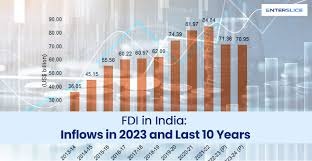
Introduction to Foreign Direct Investment (FDI)
One of the main forces behind economic growth is Global Direct Investment, which allows nations and companies to thrive internationally. It describes the financial commitment made by a person, organization, or other entity from one nation to ventures in another. In contrast to portfolio investments, foreign direct investment (FDI) entails creating a long-term interest by obtaining ownership or control of a business, infrastructure, or assets in the host nation.
FDI is essential for transferring technology between countries, creating jobs, and encouraging innovation. It provides much-needed cash inflow, access to international expertise, and contemporary infrastructure to host nations like India. FDI gives investors the chance to diversify their holdings, investigate new markets, and increase returns.
The government has recently made numerous efforts, including easing FDI regulations in various industries, PSUs, oil refineries, telecom and defence. India’s FDI inflows reached record levels during 2020-21. The total FDI inflows stood at US$ 81,973 million, a 10% increase over the previous financial year. According to the World Investment Report 2022, India was ranked eighth among the world’s major FDI recipients in 2020, up from ninth in 2019. Information and technology, telecommunication and automobile were the major receivers of FDI in FY22. With the help of significant transactions in the technology and health sectors, multinational companies (MNCs) have pursued strategic collaborations with top domestic business groupings, fuelling an increase in cross-border M&A of 83% to US$ 27 billion.


India’s FDI inflows have grown 20 times from 2000-01 to 2021-22, with cumulative inflows reaching US$ 871.01 billion by June 2022, driven by improved ease of doing business and relaxed norms. Between January-March 2022, total FDI inflows were US$ 22.03 billion, with equity inflows at US$ 15.59 billion. In FY 2021-22, the computer software and hardware sector led with US$ 14.46 billion, followed by automobiles (US$ 6.99 billion) and trading (US$ 4.53 billion). Key contributors included Singapore (US$ 15.87 billion), the US, and Mauritius, while Karnataka attracted the highest FDI at US$ 22.07 billion. By August 2022, India received 811 industrial proposals worth US$ 42.78 billion, reflecting sustained investor interest.
FDI Advisory Services in India | Expert Foreign Investment Guidance
Global CA offers specialized Foreign Direct Investment (FDI) advisory services to help businesses and individuals navigate the complexities of investing in India. Our team of experts provides end-to-end solutions, including:-
Regulatory Compliance: Making sure that India’s FDI regulations under the Foreign Exchange Management Act (FEMA) are followed.
Assisting in the establishment of joint ventures, wholly-owned subsidiaries, project offices, or branch offices in India is known as FDI setup assistance.
Approvals & Documentation: Smooth assistance with the FDI approval procedure, including preparing and submitting the necessary paperwork.
Taxation and Structuring: Improving tax arrangements for overseas investors in order to optimize return on investment.
Business Expansion Consulting: Strategic perspectives on Indian market prospects, industry-specific laws, and operational plans.


FDI Services Offered by Global CA :-
FDI Compliance Under FEMA
.Guidance on compliance with the Foreign Exchange Management Act (FEMA) and Reserve Bank of India (RBI) guidelines.
. Assistance with regulatory filings, reporting requirements, and cross-border fund transfers.
